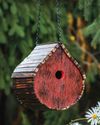
Males and females of many bird species display different traits and behaviors, and this is especially true for hummingbirds.
According to Peter Pyle, staff biologist at The Institute for Bird Populations, the real difference between adult male and female hummingbirds is in the head and neck feathers.
Females do not have full bright gorgets as the males do. Instead, in most species, they sport white throats that are sometimes spotted with dull gray-brown dots, and perhaps a small patch of iridescent feathers, depending on the species. They also tend to have slightly less-vibrant back and wing feathers.
Reason to Shine
Male hummingbirds have showier feathers for one reason: to attract potential mates. "It's all for display purposes," Peter says. He notes that they have an impressive trick to get the females' attention.
"The males can flip their gorget feathers in the sun," he says. "So when a female lands near a male at his courting post, he knows how to flip his throat so it looks like a strobe light that flashes on and off."
This story is from the August/September 2023 edition of Birds & Blooms.
Start your 7-day Magzter GOLD free trial to access thousands of curated premium stories, and 8,500+ magazines and newspapers.
Already a subscriber ? Sign In
This story is from the August/September 2023 edition of Birds & Blooms.
Start your 7-day Magzter GOLD free trial to access thousands of curated premium stories, and 8,500+ magazines and newspapers.
Already a subscriber? Sign In

Clever Cowbirds
Learn more about these birds that are infamous for letting others raise their young

Ask the Experts
Pros offer spring plant care tips and tough IDs

Rustic diy Birdhouse
Whether you're hardcore handy or an everyonce-in-a-while crafty person, you probably have a small pile of scrap wood handy. Grab your tools and turn your extra materials into any house wren's dream nest box.

THE LATEST IN Lilacs
Learn about updated varieties of this timeless classic and how to take care of them

Meet the ORIOLES
GET TO KNOW eight TYPES SEEN THROUGHOUT THE U.S. AND WHAT MAKES EACH ONE STAND OUT

CBD FOR YOUR PAIN
Everyone feels the hurt as you age, but CBD can help you deal with it

Welcome, New Blooms
Update your yard with 2024's freshest florals

Western Blues
Beckon these regional bluebirds to your yard with nest boxes and mealworms

Incredible Eggs
Fun facts about these tough yet fragile wonders

Life Well Lived
Surprising facts about bird life spans